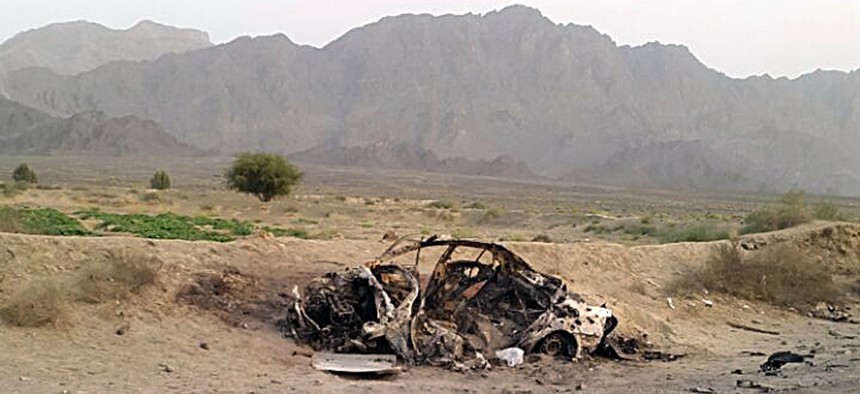
This photo taken by a freelance photographer Abdul Salam Khan using his smart phone on Sunday, May 22, 2016, purports to show the destroyed vehicle in which Mullah Mohammad Akhtar Mansour was traveling in the Ahmad Wal area in Baluchistan, Pakistan. Abdul Salam Khan/AP
The Drone War Crosses Another Line
America took an unprecedented step over the weekend when Obama authorized the Pentagon rather than the CIA to carry out an airstrike inside Pakistan.
Following the death of Taliban leader Mullah Akhtar Muhammad Mansour in an American drone strike in Pakistan on Saturday, U.S. Secretary of State John Kerry remarked that “Peace is what we want” in Afghanistan. “Mansour,” he said, “was a threat to that effort.” Confirming Mansour’s death on Monday, President Barack Obama said the Taliban’s chief, who had held the position officially for less than a year, had “rejected efforts by the Afghan government to seriously engage in peace talks and end the violence that has taken the lives of countless innocent Afghan men, women and children.”
The strike that killed Mansour crossed numerous lines that have constrained America’s fight with the Taliban, and its drone war in Pakistan, up to this point. It was remarkable for its location and timing, as well as the public acknowledgment that accompanied it. Mansour was reportedly killed while traveling in Pakistan’s Baluchistan province, where much of the Taliban’s leadership has been based since being driven out of Afghanistan following the U.S. invasion in 2001. Yet despite the well-publicized Taliban presence there—the group’s leadership council, the Quetta Shura, is named after the province’s capital city—the U.S. drone war in Pakistan hadn’t targeted the insurgent leadership at its home base prior to Saturday. It has stuck to alleged militants in safe havens in the tribal areas farther north. As Bill Roggio noted in Long War Journal over the weekend, “A strike in Baluchistan is unprecedented.”
Even in the tribal areas, the American drone campaign in Pakistan has been decelerating in recent years as the Obama administration has sought to facilitate peace talks between the Taliban and the Afghan government. Kerry and Obama both suggested that Mansour’s death could remove an obstacle to those talks; as Ali Latifi and Shashank Bengali noted in The Los Angeles Times, Mansour, having earlier signaled support for reconciliation, “presided over a resurgence of the Taliban’s fighting capabilities and made a public statement last year calling for ‘jihad until we bring Islamic rule’ to Afghanistan.”
And Saturday’s strike was carried out not by the CIA, which runs and doesn’t acknowledge the U.S. drone campaign in Pakistan, but by the military—which means that unlike the supposedly covert strikes carried out by the intelligence agency, this one was publicized by the Pentagon spokesman, on Twitter. And it means that, like the 2011 commando raid into Pakistan that killed al-Qaeda leader Osama bin Laden, Saturday’s strike involved public celebration of an attack in a country with which the United States is not, technically, at war—and which, in theory, is an ally in the war on terrorism.
Meanwhile, America’s longest war continues over the border, and as American troops have changed their focus to support and counterterrorism after declaring an official end to combat operations in 2014, the sides in Afghanistan’s civil war are fracturing. “Pro-government” forces sometimes fight each other. The Wall Street Journal reported over the weekend, citing Afghan and U.S. officials, that the Afghan government is paying one faction of the Taliban in order to exacerbate divisions within that group. (Though spokesmen for the U.S. military and the Afghan government, as well as a commander of the Taliban faction allegedly receiving support, all denied this to the newspaper.)
Those divisions were prominent when Mansour officially took the helm of the movement a year ago, after the announcement that Mullah Mohammed Omar, the Taliban leader, had died two years earlier—news that sparked a succession struggle. Though some Taliban figures may prove more receptive to negotiation than Mansour did, it doesn’t necessarily follow that his death will be a force for peace in Afghanistan, especially if there’s a new succession struggle or if the next leader proves unable to enforce cohesion within the movement. (Indeed, one possible successor, is Mansour’s former deputy Sirajuddin Haqqani, who is opposed to talks.)
At the same time, research on duration of civil wars suggests that the more sides there are in a conflict, the more difficult it is to end. David E. Cunningham, an associate professor in the Department of Government and Politics at the University of Maryland, has found that “civil wars last longer, and are more resistant to negotiated agreement, when they contain more actors who can block settlement.”
It was the chaos of a multi-sided civil war that brought the Taliban to power in Afghanistan to begin with. The United States and Saudi Arabia, via Pakistan, funded, armed, and helped train the groups of fighters that drove the Soviet Union from Afghanistan in the 1980s; in the 1990s, with no particular group strong enough to impose its will on the others or the rest of the country, but several plenty strong enough to help destroy Afghanistan, they turned their weapons on each other. As America tries to conclude its 15-year military engagement in Afghanistan, American leaders appear to be betting on splintering the insurgency even as they inadvertently sow divisions on the pro-government side through the liberal distribution of arms and cash. The risk is leaving behind another fractured battlefield of independent armed groups like the ones that stoked so much misery in Afghanistan two decades ago. Except that this time, the sides have more money and better weapons.




